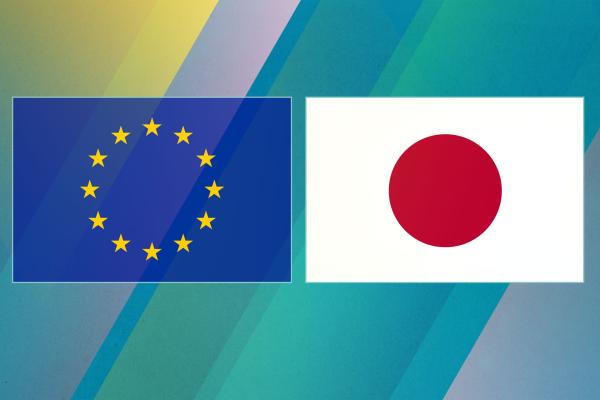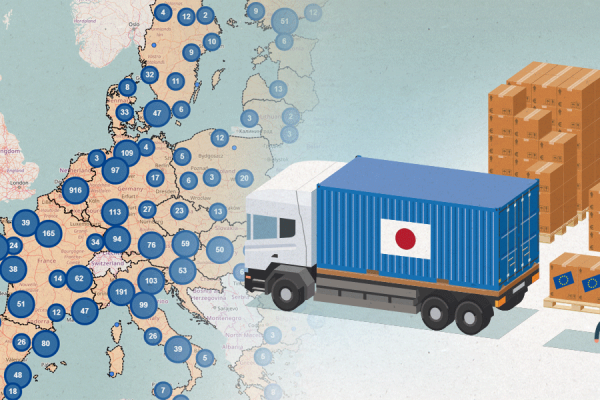- Country or region
- Japan
- Trade topics
- Negotiations and agreements
- Trade policy
1 February 2024 marked the 5th anniversary of the entry into force of the EU-Japan Economic Partnership Agreement (hereafter ‘EPA’). Its full and effective implementation remains a key political priority.
The EPA was signed on 17 July 2018. Based on the outcome of the negotiations, the European Commission produced an economic impact analysis in July 2018, which provides a comprehensive overview of trade and economic relations between the EU and Japan, and describes the context and current functioning of the EU-Japan EPA. It also provides a good overview of Japan as a trade partner for the EU.
Trade picture
- Japan is the EU’s 2nd biggest trading partner in Asia, after China. At the same time, Japan is the EU's 7th largest partner for exports and imports of goods (ranking 6th for EU exports of goods and 8th for EU imports).
- Total bilateral trade in goods and services increased by 9% between 2019, when the EPA entered into force, and 2023 (from €173 billion to €188.6 billion).
- Bilateral trade in goods with Japan is highly concentrated in the industrial sector, which represented 93% of the bilateral goods trade in 2023. Trade in agricultural products amounted to 6.2%.
- Imports of goods from Japan to the EU are dominated by machinery, motor vehicles, chemicals, optical and medical instruments, and plastics.
- EU exports of goods to Japan are dominated by chemicals, motor vehicles, machinery, optical and medical instruments, and food and drink.
- Between 2019 and 2022, EU exports of goods to Japan grew by 13.8% (from €62.6 billion to €71.3 billion), while EU imports grew by 11% (from €63 billion to €70 billion).
- In 2023, EU exports of goods contracted by 10% (€63.9 billion) compared to 2022), due to a reduced surplus in chemicals (resulting from a fall in exports of pharmaceutical products, and in particular, Covid-19 vaccines), and other factors including inflation and exchange rate variations.
- Despite contracting in 2023, bilateral trade in goods between the EU and Japan has increased by 7% since the entry into force of the EPA, reaching €134 billion (compared to €125.6 billion in 2019).
- In 2023, a surplus of €11.8 billion in total trade with Japan was driven by trade in services. Trade in services amounted to €54.2 billion in 2023 (compared to €47 billion in 2019), representing an increase of 14.3%, with the EU enjoying an €18 billion surplus.
- Japanese investment stock in the EU is very significant (€236 billion), mainly in the Netherlands and Germany, while EU investment in Japan amounts to €92 billion (2022 figures).
The EU and Japan
The EPA has achieved a high degree of trade liberalisation (at full implementation, it liberalises 99% of tariff lines for the EU and 97% of tariff lines for Japan, with partial liberalisation of the remaining lines).
The slightly lower degree of liberalisation for Japan can be explained by the sensitivity of the agricultural sector. However, with respect to the 3% of tariff lines that are not fully liberalised, Japan has given significant concessions in terms of tariff rate quotas and/or tariff reductions. Furthermore, the lower figure is also largely compensated by the significant effort made by Japan in addressing a large number of non-tariff measures.
Industrial tariffs are to be fully eliminated on both sides at the end of the transitional periods established by the EPA. The agreement has ensured a significant opening of the Japanese agricultural market to EU exporters. Preferential access for the EU to the Japanese market takes the form of tariff-rate quotas for 25 agricultural product categories (in particular, for some key exports, such as cheeses, starches and several food preparation items), as well as of total or partial tariff liberalisation at entry into force or at the end of a transitional period (for instance, for meat exports).
In the sanitary and phytosanitary (SPS) area, the implementation of the EPA has led to improved market access for European beef producers, following Japan’s approval of certain Member States' beef applications, as committed at the EU-Japan Summit in July 2023. The EU and Japan continue to work on improving market access for poultry and pork (with mutual recognition projects on regionalisation for Highly Pathogenic Avian Influenza (HPAI) and African Swine Fever (ASF)), as well as for fruits. In addition, the EU and Japan are working to simplify market access approval procedures for plant products.
Since the EPA's entry into force, the list of geographical indications that it protects has been extended three times, for a total number of 423 GIs (291 for the EU, 132 for Japan).
On 1 July 2024, new provisions on cross-border data flows were added to the EPA, facilitating business on both sides and sending a strong signal against digital protectionism.
Moreover, through the update of the EPA's ‘Car Annex’ in 2021, and by incorporating additional UN regulations, the EU and Japan are striving to further align their regulatory frameworks in the automotive sector with the internationally harmonised rules of the United Nations Economic Commission for Europe (UNECE).
Beyond the institutional structure set up by the EPA, the trade and investment relationship between the EU and Japan is supported by a number of bilateral dialogues and other specific initiatives:
- The High-Level Economic Dialogue (HLED), which meets at ministerial level, and focuses on economic issues beyond the EPA. Recent dialogues have been devoted to strengthening cooperation on economic security (see 'Joint Press Statement on the 5th EU-Japan High Level Economic Dialogue').
- The EU-Japan Business Round Table allows for a dialogue and an exchange of views between government authorities and businesses from both sides.
EU companies exports and investment into Japan are supported by the Executive Training Programme and the EU Gateway Programme, which provide European enterprises with logistical and legal assistance and with business match-making events.
The EU-Japan Centre for Industrial Cooperation promotes all forms of industrial, trade and investment cooperation between the EU and Japan by helping EU and Japanese businesses to exchange experience and know-how, with a particular emphasis on SMEs.
Committees and Dialogues
The EU and Japan meet regularly to discuss issues and best practices and oversee the proper functioning of the agreement.
The European Commission publishes the agendas (when available) of the committees set up by the EU-Japan EPA, as well as reports and other documents, to provide information about the different steps of the EPA implementation process. This is part of its commitment to a more transparent and inclusive trade and investment policy.
Technical committee, working groups and other bodies: meeting reports and other documents
Trading with Japan
- Importing into the EU from Japan
- EU trade defence measures on imports from Japan
- Exporting from the EU to Japan
- Trade relations are part of the EU's overall political and economic relations with Japan
- Japan is a member of the World Trade Organization
Exporters' stories
Energy efficiency, mobility and security are three global megatrends in modern society. They are also the central challenges that Infineon addresses with its semiconductor and system solutions.
Latest news
Today, the fifth meeting of the Joint Committee established under the EU-Japan Economic Partnership Agreement (EPA) heard that bilateral trade and investment relations continue to expand and deepen.
Today, the landmark deal on cross-border data flows between the EU and Japan entered into force.
EC-TRADE/2024/OP/0003 Study in support of an ex-post evaluation of the Agreement between the European Union and Japan for an Economic Partnership


